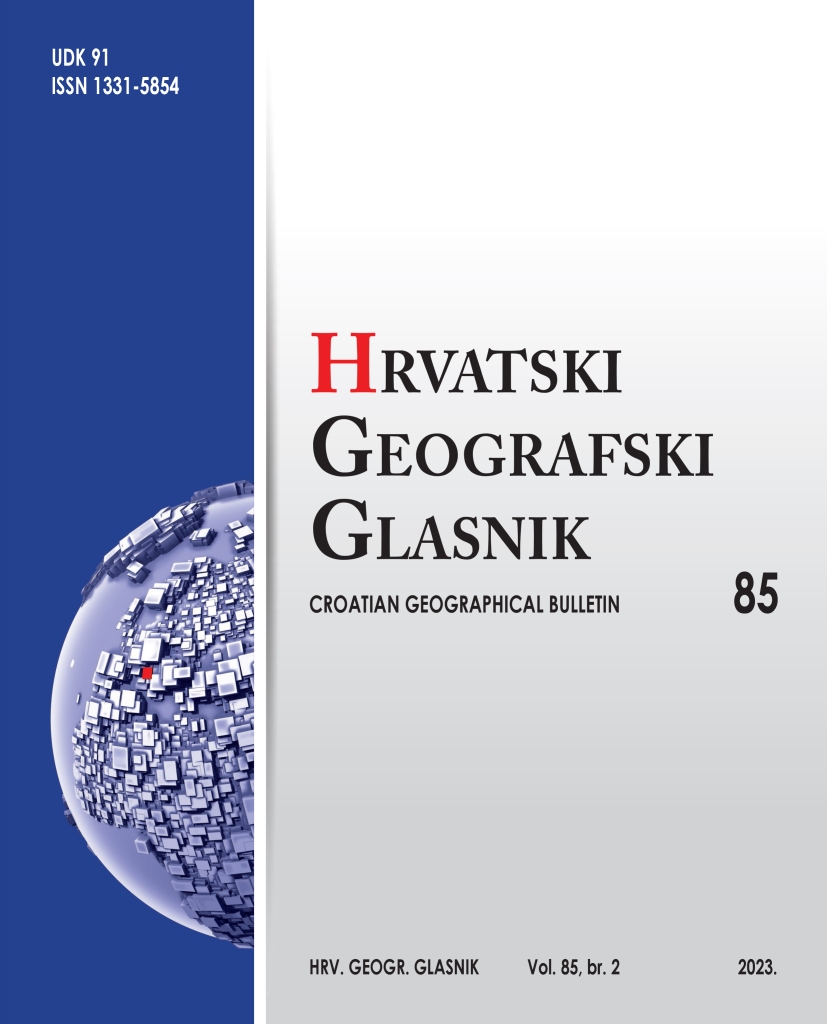ISSN
printed version: 1331-5854
on-line: 1848-6401
Address
Hrvatski geografski glasnik
Marulićev trg 19/2
pp 595
10000 Zagreb
hgd@geog.pmf.hr
The journal publishes the results of original theoretical and empirical research, reviews from all geographic disciplines, spatially oriented papers from geosciences and other related scientific disciplines, as well as interdisciplinary papers. The journal particularly welcomes papers focused on spatial issues in Croatia, Central, Southern and South-Eastern Europe, as well as papers that present the results of previous research and themes published in the Hrvatski geografski glasnik/Croatian Geographical Bulletin. The journal is issued twice a year. Each submitted manuscript id reviewed by two peer-reviewers.
The journal is indexed or abstracted in: Web of Science Core Collection – Emerging Sources Citation Index (ESCI), Scopus, Cab Abstracts, CSA Sociological Abstracts, Current Geographical Publications, EBSCO Academic Search Complete, Geobase, SAGE Urban Studies Abstracts, Hrčak
Scientific areas: Interdisciplinary sciences (field of geography) and the related areas of natural and geosciences as well as social sciences and humanities.
Last issue: Hrvatski geografski glasnik/Croatian Geographical Bulletin 85 (2)
The research topic is geographical marginality, and the main aim of the research is to develop a methodology for identifying, analyzing and determining marginal areas of Međimurje on the spatial level of settlement. Exploratory factor analysis was used in the research via GIS methods. The 30 selected variables were used for exploratory factor analysis. The suitability of the variables was tested using the Kaiser-Meyer-Olkin test and Bartlett’s test. Free, open source R, JASP and QGIS software were used. In the analysis, six factors were identified, by which the characteristic types of settlements in Međimurje were identified: 1) Spatial concentration and economic dynamics; 2) Demographic dynamics and population aging; 3) Education and economic diversification; 4) Availability of central functions; 5) Traditional extensive agricultural production; and 6) Stationary work contingent focused on primary activities. Based on the factor scores, a Međimurje index of marginalization of settlements (MIMaNa) was calculated. Based on this index, the degree of geographical marginality of settlements in Međimurje was determined.
Islands and coastal regions are experiencing significant impact from sea-borne litter, and this issue also affects the Croatian islands, including Pašman Island. A comprehensive research approach has been adopted to assess the landfill sites on the island, which involves applying an integral list of indicators to existing landfills. Indicators have been connected to statistical data, and in the last phase of the research the perception of the islanders towards waste management was examined.
The research done in 2018 involved accessing 32 solid litter sites, including 10 located on the coastline and 22 inland, with particular attention given to the composition of the waste. Results revealed that plastic litter was more prevalent in coastal sites (55%) than in inland sites (20.9%). Although the local government reported no landfills on the island in February 2021, islanders disputed this claim and confirmed the presence of solid waste disposal sites. A qualitative research study conducted in January 2022 indicated that waste management has recently improved. The data collected from the fieldwork has informed a proposal for future waste management measures in isolated, inhabited coastal areas.
M. Balija: Motives, Factors, and Finality of Return Migration from Germany to Croatia
The research aims to determine the motives, finality of return, and the importance of geographical proximity of the country of origin and destination for return migration of Croatian citizens who immigrated to Germany after Croatia’s accession to the EU. The main motives for the return of the respondents are the fulfilment of a goal abroad, connection to Croatia, and dissatisfaction with German society. The respondents are connected to Croatia by family, friends, and love for their homeland, but not by economic conditions, which were pointed out as a possible push factor for reemigration from Croatia in the future. In the case of going abroad again, some respondents might consider Austria, in addition to Germany, due to its geographical proximity to Croatia. The experiences of the respondents showed that more effective population policies are needed, especially related to housing and labour policies, and a better standard of living, which were mentioned as strong push factors for emigration from Croatia.
In the scientific community, the concept of services of general interest is relatively new, even though its components have been examined in various ways for several decades. The term “service of general interest” is a political and normative expression introduced by the European Union. While it is challenging to provide a precise definition, services of general interest are generally understood as service activities that public administration bodies in a specific country or region designate as activities contributing to the public welfare. In geographical research, individual elements of this concept are often analysed, such as the provision of infrastructure and services in settlements, the organization of central places, or the accessibility of services in a specific area. This paper aims to organize fundamental knowledge about services of general interest, as found in scientific and professional literature; with the intention of analysing definitions and classifications of these services, exploring the scientific interest in distinct service categories, examining the spatial organization of services, and investigating their accessibility and adaptation in response to modern social, economic, and technological changes.
